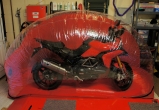
Time To Get Your Motorcycle Ready For Storage
By Larry Scalzitti
Senior Road Captain
It’s been a nice week for riding, so the idea of storing your bike for the winter might be off your radar, but . . . it’s never too early to start planning. There are many things to consider – storage location, cleaning, maintenance, tires, and more. I’ll talk to what I think are important items to look at.
STORAGE LOCATION
First you need a place to store it safely and securely. You want to find a place that is heated, well ventilated, free of rodents and secure. It’s also great if you can have electrical outlets and access to your bike throughout the year.
When I was single, I stored my motorcycle in the basement of the apartment I lived in. The base-ment had storage lockers for each tenant, a few wash-ers and dryers, a water heater, a furnace and most im-portantly a 7 foot section of empty wall space. I kept it there for three winters, under a tarp and chained to a large pipe. Much to my amazement no one ever messed with it or complained about it being there. It was probably a good thing that I was the only one in the complex with a motorcycle.
Most of us keep our bikes in our garages, but some of us will store them away from home. A popu-lar option today is to let your dealer store your bike in exchange for the promise of either having a minimum dollar amount of maintenance completed or that you purchase a minimum amount of parts or accessories.
A third option is to rent space for your bike. When I first opened my motorcycle training school, I leased space from a friend for all of my training bikes and my personal bikes as well. Judy was glad to have more garage space available and now she had the ability to park her car inside the garage for the winter. Lots of points for me on that move! The nice thing about storing the bikes at my friend’s warehouse was that the space was heated and secure.
From there I tried renting a space from one of the popular storage places. It wasn’t heated. There was no electricity and access to the lot was nowhere near as secure as I thought it should have been. I did-n’t realize how good I had it at my friend’s building, until that experience. I now have my own warehouse, so it is heated and secure and I can keep my bikes safe again. By the way if you know anyone who needs to store a bike or a car, please share my contact information with them. I still have a few spots availa-ble for this winter.
CLEAN UP TIME
If you’re like me and don’t clean your bike that often or if you own a Harley and clean your bike religiously, now is the time to get serious about prop-er care. Give your ride a good wash and wax. It will pay dividends when you get it ready to go in the spring. The wax will act as a barrier against moisture and help prevent rust formation. Some will spray met-al parts with WD-40 to inhibit corrosion. Years ago a friend suggested I start using DuPont Teflon Multi-Use Lubricant spray and I’ve found it to be very ef-fective as well.
SERVICE YOUR FLUIDS
If your brake or clutch fluids haven’t been changed in the last two years or 18,000 km (11,000 miles), do it now. These hygroscopic fluids absorb moisture and the contaminated fluid will cause corro-sion inside the systems which may give problems when the motorcycle is used next spring. Be sure to use the correct fluids and note the warnings and in-structions in the service manual. If you don’t have the experience or confidence to do this, have your dealer complete the service.
If your motorcycle is liquid cooled, the coolant also requires a change every two years or 15,000 miles. Make sure you use the right coolant for your motorcycle engine. You can find that information in your owner’s manual.
I like to change my oil before placing the bike in storage. Used oil can contain corrosive contaminants that when coupled with moisture can damage the internals of your engine. Better to be safe than sorry.
Fill up your tank to prevent condensation during storage. Many riders will add fuel stabilizers to the tank. If you do make sure it is compatible with ethanol blended fuels. You should also ride your bike after the additive has been applied, allowing it to circulate through your carburetor or injectors. On my carbureted bikes, I will turn off the fuel supply valve and run the bike until the gas is clear of the carbs to help avoid gumming up the jets during storage. Stale fuel occurs when aromatics (the lighter additives) evaporate leav-ing a thicker, sour smelling liquid. If left long enough, it will turn into a gum, plugging the jets and passages of the carbs. I ride my bikes at least once a month, so I don’t add a stabilizer, unless I know I won’t be riding the bike much during the winter.
TIRES & BATTERY
You have a few choices with your battery. One option is to have your battery wired up so that you can connect a trickle charger to it anytime you want. For longer storage periods, I prefer to hook up the charger every few weeks to keep the battery fully charged. Motorcycles often have a small current drain even when the ignition is switched off, and a discharged battery will sulfate and no longer be able to sustain a charge.
Some riders prefer to remove the battery from their motorcycle whenever it’s in storage. Then you can attach the trickle charger to the battery during storage.
If you have a conventional lead acid battery now is a good time to check the electrolyte level. Add distilled water to any of the cells that are low and then charge the battery.
Check both front and rear tires with your air pressure gauge. Make sure each tire is properly inflated to the maximum recommend pressure. As it gets colder, air condenses in your tire so it is im-portant to air them up and keep your tires healthy.
If you have a center stand, store your motorcycle on it. This will take the weight of the bike off the tires. If you only have a side-stand you will want to keep your motorcycle tires from being in di-rect contact with the cement floor on the same spot all winter. One option is move your bike every so often. Another is to put material underneath the tire. Rubber mats or some kind of synthetic flexible material will do. You can also place a 1/4″ to 1/2″ piece of cardboard or wood board under each tire will help keep the rubber raised up from a floor. Michelin recommends placing a barrier between your tire and the storage sur-face.
DO NOT use a tire dressing on tires (such as Armor-All or tire cleaning foam) as this will make the tires hard and slippery.
COVER IT UP
Now you can add the final layer of protection, a good quality breathable cover for your bike. Feel free to remove the cover during the storage season and polish your bike or if you’re lucky take it out for a ride. Remember in the winter, 50 degrees and sun feels like a warm summer day!





